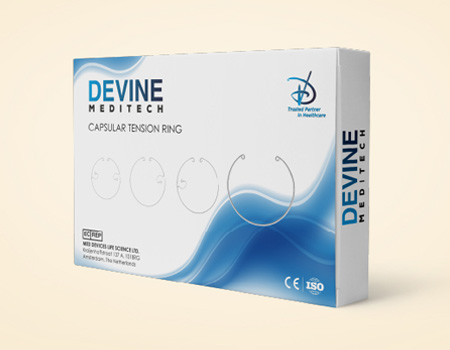
Technological developments in ophthalmology have transformed cataract surgery, rendering it safer and more efficient than ever. At Devine Meditech, the Cionni Ring and the Capsular Tension Ring (CTR) are two developments that have made a major difference in surgical results. The tiny yet essential devices are utilized in different clinical circumstances and serve slightly varied goals, but they are essential in stabilizing the capsular bag during cataract surgery. Let's examine these devices' distinctions in detail to see how they are related to ophthalmic surgery.
The Capsular Tension Ring, or CTR for short, is a flexible device with a circular or horseshoe-shaped structure that is composed of polymethyl methacrylate (PMMA) or polyethylene. During cataract surgery, it is placed into the cellular bag to offer assistance and stability. The CTR's major job is to support the weak or injured capsular bag to keep it from contracting and to preserve its shape.
When the fibers holding the lens Capsular are impaired, as occurs with zonular weakening or dialysis, CTR implantation is especially helpful. Numerous factors, such as trauma, aging, or specific systemic illnesses like pseudoexfoliation syndrome, can result in zonular weakening. Insufficient zonular support can cause the capsular bag to become instability or detached during surgery, which can result in problems such as intraoperative decency or displacement of the intraocular lens (IOL).
The CTR lowers the risk of these issues and makes it easier to position the IOL correctly by fastening the capsular bag and spreading the force applied during surgery. Additionally, it supports the maintenance of a clear visual axis, which helps patients having cataract surgery achieve the best possible visual results.
A version of the classic Capsular Tension Ring created to meet particular difficulties in cataract surgery is called the Cionni Ring. In contrast to the conventional CTR, which offers consistent support to the whole capsular bag, the Cionni Ring has a hook or eyelet on either end. In cases of severe zonular weakening or subluxation, this special design enables further anchoring of the capsular bag to the sclera or iris, boosting stability.
When there is severe zonular dehiscence or insufficient capsular support, the Cionni Ring is especially helpful. The Cionni Ring aids in centering the capsular bag and preserving the IOL's correct alignment by attaching it to the surrounding tissues. It also reduces the possibility of postoperative problems including IOL tilt, decency, or displacement.
The Cionni Ring not only gives surgeons mechanical assistance but also more versatility in handling complicated cases. Adjusting the position and angle of the eyelets enables customized strategies according to the unique anatomical difficulties that arise during surgery. When working with individuals who have experienced catastrophic traumas, congenital anomalies, or prior ocular procedures, this adaptability is extremely useful.
In contemporary cataract surgery, the Capsular Tension Ring and the Cionni Ring are essential tools for addressing different levels of zonular weakness and capsular instability. For complicated instances, the Cionni Ring gives improved fixation and customization options, while the CTR supports the capsular bag generally. At Devine Meditec, the choice of device depends on several factors, including the level of zonular impairment, the presence of concurrent ocular pathology, the surgeon's preference, and experience.
Regardless of the specific technique used, the ultimate goal is always the same: to optimize surgical outcomes and improve patients' satisfaction and appearance. We may anticipate more advancements in the development and use of Capsular tension rings as technology develops, which will result in even more accuracy and effectiveness in cataract surgery. These advancements will allow ophthalmic surgeons to treat people who have cataracts and related disorders more securely and effectively, thereby improving their quality of life.